By Roy Smith, historical images copyright Bob Dance
Our lead photo is of the Gordini Transporter Recreation, based on a Laffly chassis and it is actually a race car transporter, not a support truck. Sadly, the original vehicle, based on a Lancia 3RO 6.8 liter, no longer exists as we are given to understand, though many stories abound.
We thought it might be interesting to recall some of the highlights or maybe lowlights of one of the most recognisable racing car support vehicles to grace the paddocks of Europe’s racing circuits in the 1950s.
We have to go back to the end of 1947 to begin the story. After the war, Amédée Gordini and his team used a variety of Simca vans and small trucks to carry parts and tow his early racing cars to the circuits. Often these vehicles would be just support vehicles carrying spares whilst the racing cars themselves were driven on the roads, unlicensed and with no lights, and at night would travel in convoy between the various Simcas driven by the mechanics.
By the end of 1947 Gordini was moving up in the world and at the annual Gordini team banquet in December 1947 there was much talk of a truck to carry the cars. A transporter to carry the single-seaters and parts to each circuit had become a necessity. However, at that time no manufacturer had a vehicle adapted for this purpose and funds for such a “special” tailor-made purchase were limited. The simplest solution was therefore to buy a truck. There were many that had been recovered from the Germans after the war and were being sold by the French Customs Administration. Gordini was on the case quickly and he had found out about three trucks and a Fiat 2.8L that were up for auction. He put in a successful bid and immediately sold two, keeping the best one and the Fiat.
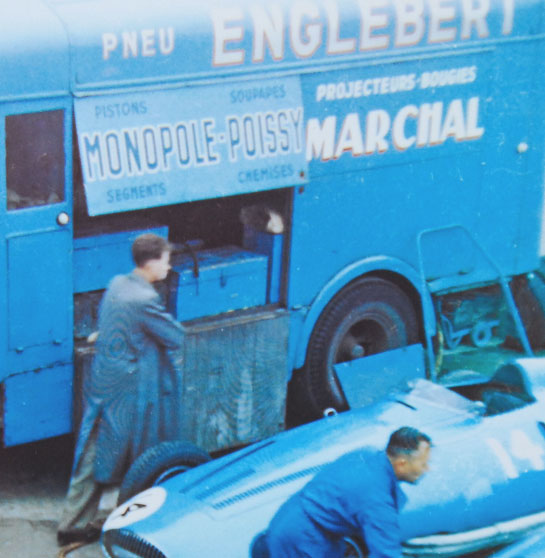
Gordini fabricator Gaby Beausser installed two large rear doors and interior fittings to carry two cars, one above the other, with shelving, a workbench and storage boxes on the Lancia truck platform. Photo copyright Bob Dance.
The truck was a 1938 Lancia Type 3 RO (chassis 5644373), with a 5-cylinder in-line 6875cc engine running on heavy diesel oil, coupled to an 8-speed gearbox. Weighing 4 tons empty, it could carry a load of 6 tons and its cabin could hold 5 passengers. Its standard-design classic chassis had a wheelbase of 4.5m and an open space length of 4.5m from the back of the seats into which a racing car of the time could fit. With twin rear wheels, it could reach 50kmh (32 mph!) fully loaded. It was immediately stripped of its original bodywork and rebuilt by Gaby Beausser (Gordini’s bodywork specialist) using duralumin sheeting. He installed two large rear doors and interior fittings to carry two cars, one above the other, with shelving, a workbench and storage boxes that were accessible from the outside, as can be seen in the photo above. Tyres could be carried inside and a trailer capable of carrying a third car could be attached to a newly fitted towing hook.
It appeared for the first time at the Pau Grand Prix on 29 March 1948 and was used over many years, clocking up hundreds of thousands of kilometres. A contemporary report in the October 1948 edition of the British magazine Motor Sport described it as follows: “The Equipe Gordini is a well-organized concern and its trucks which carry the racing cars are models of efficiency. Two cars are carried in each truck. The first one is run up the back ramp on to a channel-section frame, which is then hoisted up by means of steel ropes and pulley-blocks attached to the roof-members of the truck, not such a hard job, as the Simca-Gordinis only weigh about 330 kilos each. Room is thus left on the floor of the truck to carry a second racing car. Spare wheels, complete with tyres, sixteen in each truck, are carried in tubular racks at the front of the vehicle, while tools and spares are again carried in drawers and lockers. Equipment like this costs money and is beyond the reach of the private owner, but it obviously adds much to the efficiency of any racing organization.”
Throughout 1948 and 1949 Robert Aumaître (affectionately known as “le Grand Robert” – he was a big man!), Gordini’s team manager, wanted the transporter to have an upgrade. It had plenty of torque but was very slow and on the roads of France and the rest of Europe at the time it took forever to get anywhere. As the Gordini team was notoriously always late in leaving for an event, the journey frequently involved great stress on both man and vehicle to arrive on time and in comfort, which it has to be said was almost non-existent! So with a short break before the Brno Grand Prix of 1949, Aumaître pressed Amédée Gordini to allow him to give it more speed. Finally Gordini agreed and gave him the go-ahead to improve the truck. Aumaître got started and created a sort of “overdrive” for the gearbox, which was tested on the Gordini team’s “test track” – the Boulevard Victor in Paris – where it reached 90kmh(56mph)! With this performance and some weight reduction in other areas, speed could now be maintained when going uphill.
Brno was a long way: even with the truck improvements it was some 35 hours from Paris. Most of the team went in the Fiat 2.8L truck, while the Patron and his lady drove down in a Coupé Simca 8. For this trip the Lancia had just the driver and co-driver; to reduce the weight to be carried, they left the trailer behind. Two single-seater racing cars were inside the truck while a sports car for another race on the same program was simply attached to the Lancia tow hook by a 2.5m bar. Gordini mechanic Emile Loison was chosen to drive in it; his only view for 1700km would be the rear of the transporter. The usual caravan left Paris and headed off for Czechoslovakia. Mechanic Vidue, driving the Lancia, kept up a good, steady 90kmh! About half way they changed drivers and Aumaître took over, wanting to give his modifications a proper test. He put his foot down and, spitting fire and flames, the Lancia at times hit 110kmh. Hitched up behind this charging monster, not able to see anything, was poor Emile, who had tremendous difficulty in negotiating the bends. In the end they reached Brno in only 30 hours. The Lancia upgrades had proven themselves in one trip.
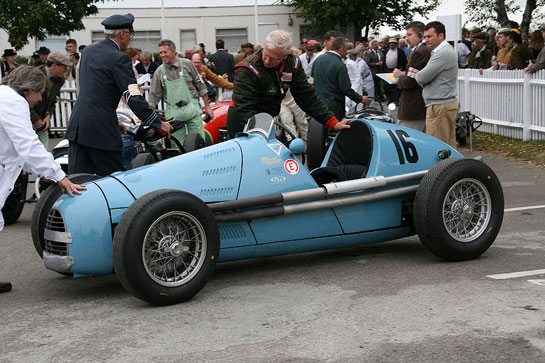
F1 Gordini, ex Jean Behra, is getting ready to go at Goodwood. This is a 1952 chassis and typical of the transporter's payload. Photo by Hugues Vanhoolandt.
Amédée Gordini’s company was always short of money and the transporter, not being a racing car, was frequently neglected and repairs were often makeshift. This was to become a critical problem in 1951 when they were off to Barcelona. It left the Boulevard Victor workshops at 3pm with its three single-seaters and Gordini personnel Vidue, Aumaître, Loris and Debord. After a stop at Vermenton for dinner, the whole team got back on the road. Vidue was driving the Lancia while his companions slept. It was nearly 10 o’clock when a worried Vidue woke the others as the transporter slowed down and stopped at the side of the road. Vidue said: “The throttle won’t work… It looks as if the clutch or transmission has let go.” And to prove his point, Vidue pushed the throttle pedal to the floor; the engine roared but was running free. Aumaître jumped out in the dark, and the next thing the others heard was, “Hey, guys, get me out of here!” Aumaître was stuck up to his chest in a sludgy stream. “Quick! I’m sinking!” he yelled, as they reached down to help, eventually managing to drag him out. However, the smell of the sludge was so terrible they had to wash him down with water they were carrying before continuing with the inspection of the Lancia.
Once he was cleaned up, investigations showed that the drive shaft was turning, but the truck wasn’t going anywhere. The axle was broken on the left side. They had to find a local garage in Vermenton; after much searching they found a small general mechanic able to do the welding repair. At 1pm, after a drink or two for friendship’s sake, they put it all back together. By 3.30pm all was complete and they set off again. Passing through Valence (at midnight), Perpignan (at 9am) and at last Barcelona. It was 3pm when they arrived at the Gordini pit. Gordini, who had gone to Spain by another route in his Aronde, only found out what had happened when they reached Barcelona. Robert Aumaître enjoyed telling him how he nearly drowned! Lessons had been learned, but Aumaître was wondering if the Lancia would hold together long enough to get back to Paris. Gordini had to give in, issuing instructions for an overhaul. The work began as soon as they got back to the workshop. The engine was dismantled and received new pistons, bearings, valves and valve springs. The gearbox and axle were refurbished as well as the clutch. All the bearings were changed, the electric circuit renewed and Beausser did a makeover on the bodywork, which had suffered a great deal this season. The trailer was given an automatic brake attachment and shock absorbers. The same rejuvenation program was also applied to the Fiat 2.8L, about which we have little information.
In 1954 the Lancia was given a new coat of paint; the blue specially created for Gordini by Villemer before the war had virtually worn off and faded almost to dirty white. “Gordini blue” was beautiful, but its major fault lay in its poor resistance to the sun’s rays.
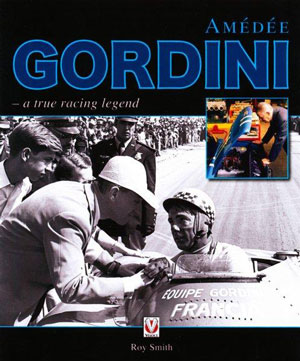 The old girl had been given new life, but by 1955 it was deteriorating again, though it was used throughout the 1955 and ‘56 seasons, as we see here in a wider-angle photo taken at the British Grand Prix (photo by the late Jim Clark’s legendary Lotus mechanic Bob Dance, who was still going strong when the author saw him at Silverstone this year).
The old girl had been given new life, but by 1955 it was deteriorating again, though it was used throughout the 1955 and ‘56 seasons, as we see here in a wider-angle photo taken at the British Grand Prix (photo by the late Jim Clark’s legendary Lotus mechanic Bob Dance, who was still going strong when the author saw him at Silverstone this year).
However, the Lancia’s days were numbered; as all good men of France know, Gordini’s era as a factory racing team was over in 1957 the doors closed on the Gordini F1 team. The Lancia 3 RO was used for the last time at Le Mans in 1957, after which it fell into disrepair. The last I heard, it had rotted away many years ago, having probably travelled the equivalent of many circumnavigations of the globe. More about Gordini and the Lancia can be found in the book Gordini by Christian Huet, whom I thank for the background for this story, and my forthcoming (in September 2012) book in English… Amedee Gordini- a true racing legend.
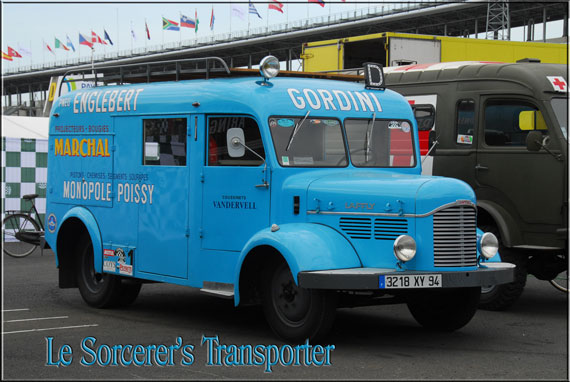
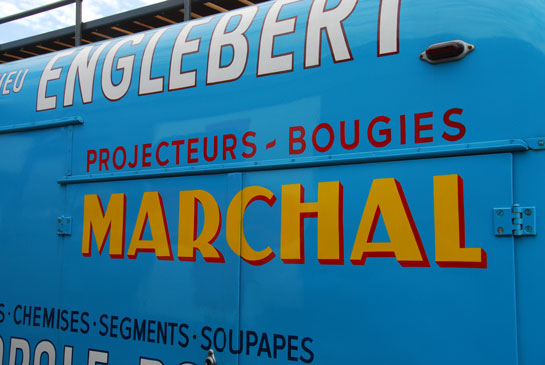
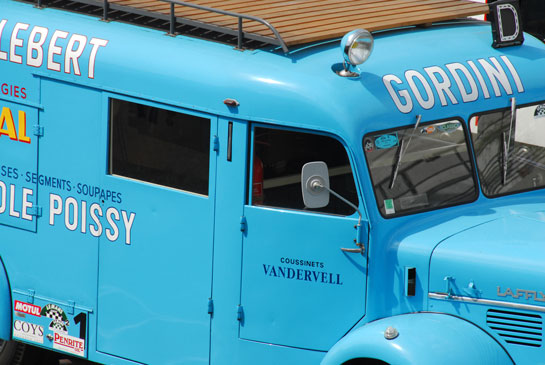
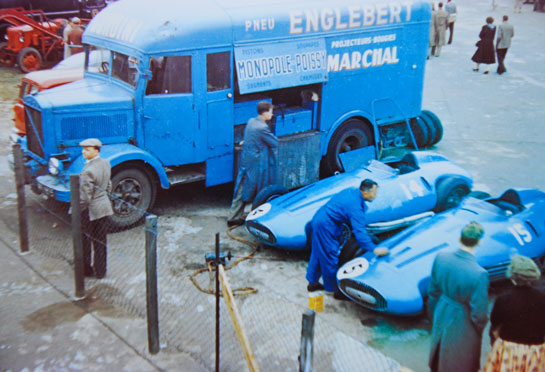
Roy,
Brilliant article, such detail-pity the original is not around still!